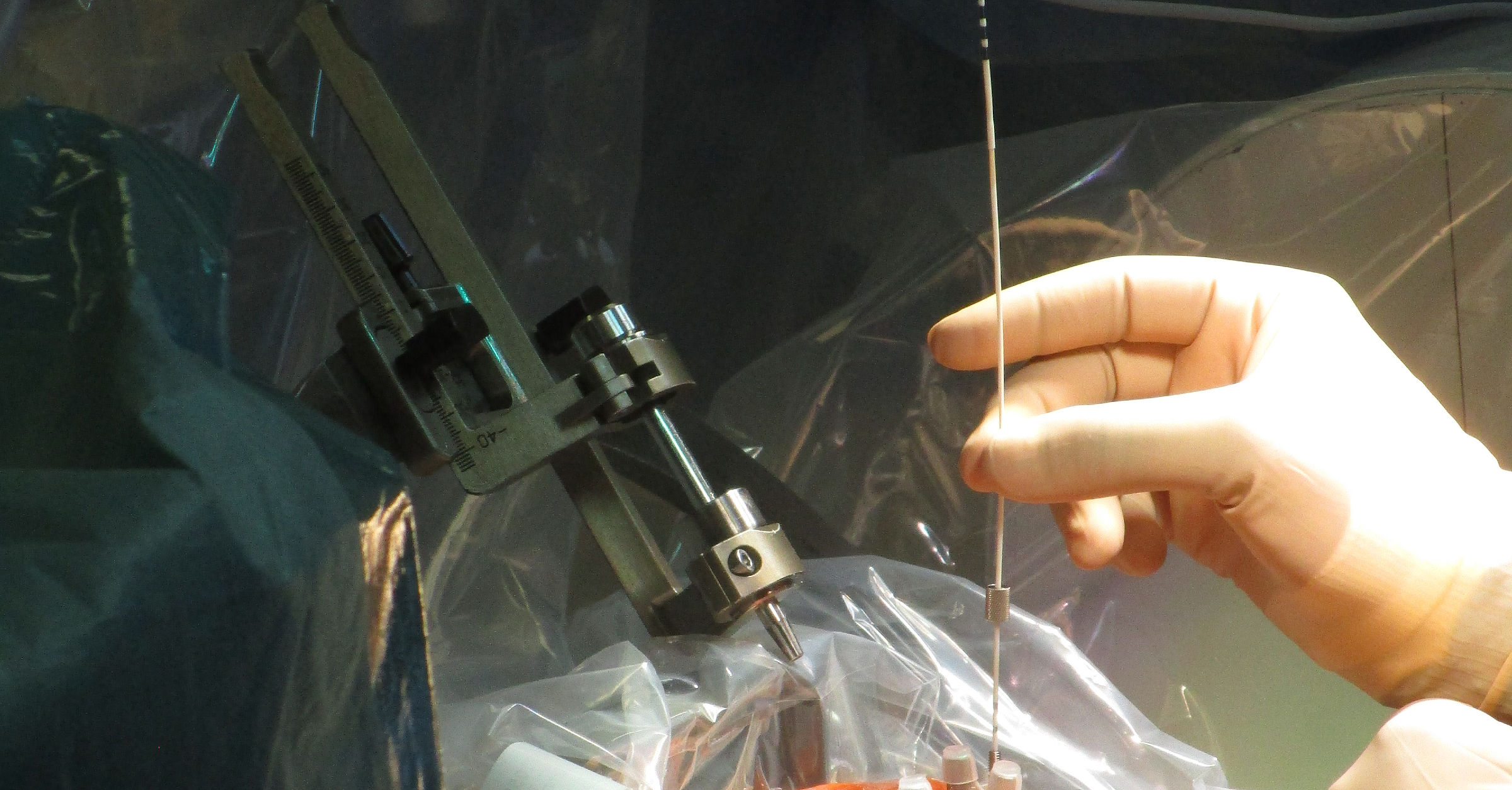

Das Ziel der Arbeitsgruppe ist es, die neuronalen Mechanismen kognitiver Prozesse besser zu verstehen.
Eine ausführliche Beschreibung der Ziele unserer Forschung finden Sie hier in englischer Sprache.
Interessenten für eine Abschlussarbeit (Bachelor/Master), eine Doktorarbeit (Ph.D. oder Dr. med.) oder eine Postdoc-Stelle in unserer Gruppe schicken bitte eine E-Mail mit Ihren Forschungsinteressen und Lebenslauf an randolph.helfrichmed.uni-tuebingen.de oder schauen unter "Stellenangebote".
In English only
I. Rhythmic building blocks of human attention: How network oscillations link perception and action.
Attention is a fundamental cognitive function necessary to efficiently translate sensory experiences into goal-directed actions . Traditionally, attention has been conceptualized as a constant spotlight that amplifies behaviorally-relevant information. Recently, several lines of inquiry probing attention on a fine-grained temporal scale revealed frequency-specific behavioral fluctuations that align with ongoing brain oscillations, indicating that attention is a discrete process. Our aim is to understand the structural and functional basis as well as the physiologic purpose of attentional rhythmic fluctuations.
See also Helfrich et al. (2018b) Neuron, Helfrich et al. (2019) Current Opinion in Psychology
II. Context-dependent predictive processing in human prefrontal cortex.
Over the last few decades, several lines of research indicated that the prefrontal cortex (PFC) provides the structural basis for goal-directed behavior based on endogenous predictions, but its functional architecture is not well understood. Our goal is to investigate how predictions are implemented in the human brain to optimize sensory processing and goal-directed behavior.
Background reading Helfrich and Knight (2016) Trends in Cognitive Science; Helfrich et al. (2017) PNAS
III. (Patho-) Physiology of human memory networks during wakefulness and sleep
Hippocampus-Prefrontal interactions are central to memory formation in the human brain. Critically, this network also constitutes a predilection site for various pathological entities that are associated with memory deficits. Our goal is to further dissect and understand the network circuitry underlying memory disorders in various patient populations (epilepsy, stroke and degenerative diseases)
Additional information: Helfrich et al. (2018a) Neuron; Winer, Mander, Helfrich et al. (2019) JNeurosci
IV. Principles of neuronal network organization in the sleeping and the unconscious (anesthesia, coma) brain.
How do different network states impact different behavioral states? Understanding principles of network organization is critical to understand disorders of consciousness. We will work with several patient populations to understand large-scale network mechanisms underlying reduced arousal states.
See also Helfrich et al. (2019) Nature Communications; Lendner, Helfrich et al. (2020) preprinted on the biorxiv
In English only
We are inviting applications for fully funded positions for
PhD students and Postdocs
with an interest in the neuronal network dynamics underlying cognitive processing and sleep physiology. The lab is conducting cognitive neuroscience studies in a clinical environment. Our key goal is to understand the network neuroscience underlying higher cognitive functions in the human brain. We are particularly interested in recruiting in the following areas:
I. Rhythmic building blocks of human attention: How network oscillations link perception and action. Attention is a fundamental cognitive function necessary to efficiently translate sensory experiences into goal-directed actions . Traditionally, attention has been conceptualized as a constant spotlight that amplifies behaviorally relevant information. Recently, several lines of inquiry probing attention on a fine-grained temporal scale revealed frequency-specific behavioral fluctuations that align with ongoing brain oscillations, indicating that attention is a discrete process. Our aim is to understand the structural and functional basis as well as the physiologic purpose of attentional rhythmic fluctuations.
See also Helfrich et al. (2018b) Neuron, Helfrich et al. (2019) Current Opinion in Psychology
II. Context-dependent predictive processing in human prefrontal cortex. Over the last few decades, several lines of research indicated that the prefrontal cortex (PFC) provides the structural basis for goal-directed behavior based on endogenous predictions, but its functional architecture is not well understood. Our goal is to investigate how predictions are implemented in the human brain to optimize sensory processing and goal-directed behavior.
Background information Helfrich and Knight (2016) Trends in Cognitive Science; Helfrich et al. (2017) PNAS
III. (Patho-) Physiology of human memory networks during wakefulness and sleep Hippocampus-Prefrontal interactions are central to memory formation in the human brain. Critically, this network also constitutes a predilection site for various pathological entities that are associated with memory deficits. Our goal is to further dissect and understand the network circuitry underlying memory disorders in various patient populations (epilepsy, stroke and degenerative diseases).
Additional information see Helfrich et al. (2018a) Neuron; Helfrich et al. (2019) Nature Commun.; Winer, Mander, Helfrich et al. (2019) JNeurosci
Key Methodology:
We are combining detailed behavioral testing with intracranial EEG recordings in humans (ECoG, sEEG, Single Unit Activity) as well as non-invasive neurophysiology (EEG, MEG) and electrical brain stimulation (direct cortical stimulation, deep brain stimulation, responsive neurostimulation). A methodological focus of the group is a multimodal approach combining invasive and non-invasive approaches (sEEG-MEG). We offer hands-on training on all aspects of study design and data collection as well as state-of-the-art analysis methods of electrophysiological data.
Skills and qualifications:
The positions are well suited for candidates from a wide-range of backgrounds, including biology, computer science, psychology, medicine, cognitive- and neuroscience. We particularly encourage applications from researchers with previous experience in human imaging or primate neurophysiology who are seeking to apply their skills to basic science questions in a clinical context with various opportunities for translational application. Prior coding experience in e.g. MatLab or Python is helpful, but not a pre-requisite. We welcome researchers with an international background. German language skills are not necessary. Tübingen offers a rich and diverse neuroscience campus, where key facilitates (epilepsy monitoring unit and MEG center) are in close proximity. PhD students will be enrolled in Neuroscience Graduate Center Training School in Tübingen (https://www.neuroschool-tuebingen.de/).
We are striving to provide a diverse and family-friendly atmosphere, which fosters international exchange with ample opportunity for collaborations.
If we have sparked your interest, please send your application, including a CV, relevant certificates or diplomas and a cover letter outlining your research interest in English or German to randolph.helfrich@med.uni-tuebingen.de
Wichtige Publikationen
2019
Helfrich, R.F., Lendner J.D., Mander B.A., Guillen H., Paff M., Mnatsakanyan L., Vadera S., Walker M.P., Lin J.J., Knight R.T. (2019). Bidirectional Prefrontal-Hippocampal Dynamics Organize Information Transfer during Sleep in Humans. Nature Communications
2018
Helfrich, R.F., Fiebelkorn, I.C., Szczepanski, S.M., Lin, J.J., Parvizi, J., Knight, R.T., and Kastner, S. (2018b). Neural Mechanisms of Sustained Attention Are Rhythmic. Neuron
Helfrich, R.F., Mander, B.A., Jagust, W.J., Knight, R.T., and Walker, M.P. (2018a). Old Brains Come Uncoupled in Sleep: Slow Wave-Spindle Synchrony, Brain Atrophy, and Forgetting. Neuron
2017
Helfrich, R.F., Huang, M., Wilson, G., and Knight, R.T. (2017). Prefrontal cortex modulates posterior alpha oscillations during top-down guided visual perception. PNAS
2016
Helfrich, R.F., and Knight, R.T. (2016). Oscillatory Dynamics of Prefrontal Cognitive Control. Trends in Cognitive Sciences

Zentrum für Neurologie
Hertie-Institut für klinische Hirnforschung
Hoppe-Seyler-Str. 3
72076 Tübingen
Tel.: +49 (0)7071 29-80442



